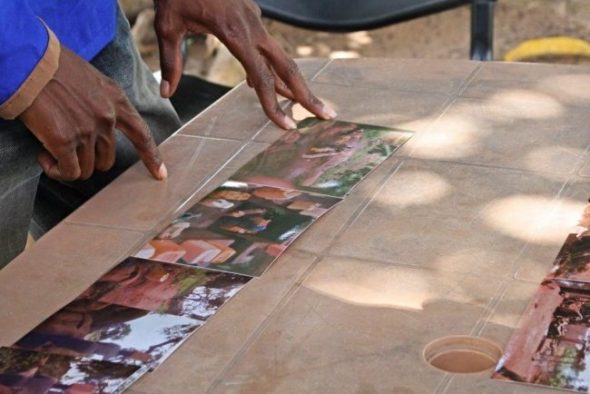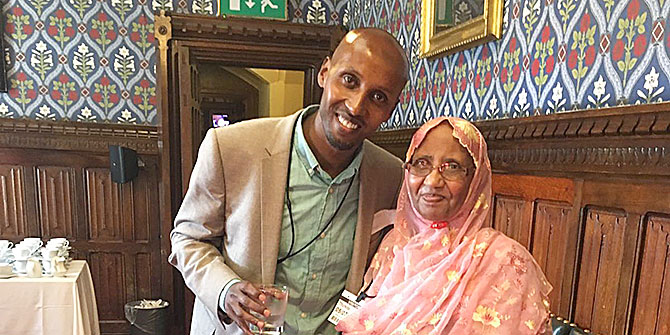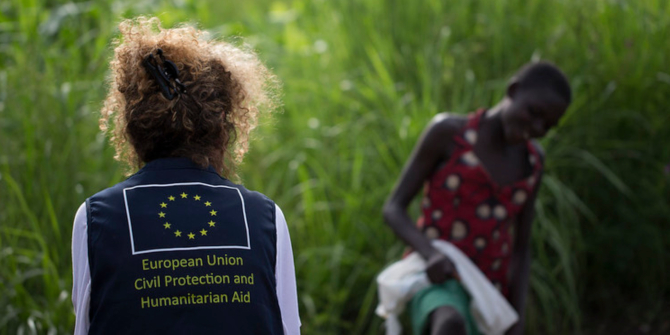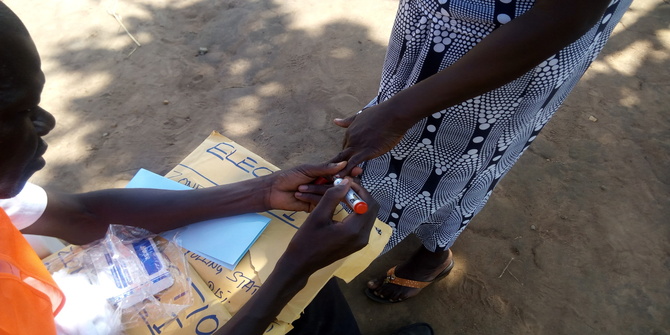The image portrayed of refugees is frequently manipulated to meet organisational needs, including by international charities which purport to transform their situation. Less research has focussed on the self-representations of refugees themselves, and how they project their own images using film and social media. Meital Kupfer presents findings based on interviews with refugee and host community video advocates in Uganda.
The starving child. The rags-to-riches redemption story of the refugee, the hard-working mother or the improvising businessman. Often, the image portrayed of refugees is far from the reality. Portraits and films depicting the refugee experience often cast it as a single category – whether it is the huddled and starving masses or the industrious and resourceful refugee – which ignore the heterogeneous experience of a population reduced to statistics. Type the words ‘Africa’ and ‘refugee’ into a Google Image search and the photos that pop up continue to reinforce preconceived notions of the experience of forced displacement.
Yet, as many groups of refugees are an over-researched population, saturated with programming, interventions and studies, the humanitarian sector also continues to reinforce stereotypical portrayals, monopolising the stories that emerge, particularly of groups from the African continent. My personal frustration stems from previous work with a large international non-governmental organisation (INGO) in Uganda – scouting for the ‘pre-selected’ story, editing and constructing narratives of the ideal ‘refugee experience’ for distant donors in Europe.
There have been many academic studies on INGO fundraising appeals and the reactions of the Western public. Boltanski, Chouliaraki, Dogra, Orgad and others examine the ‘politics of pity’ and the usage of negative or positive imagery to elicit a reaction from a distant spectator. Yet, there are scant papers published on the opinions of the human subjects of films and photographs commissioned by INGOs. While Save the Children’s People in the Pictures Report from 2017 and Radi-Aid’s 2018 report with the University of East Anglia sought to interview recipients of aid or subjects of INGO photographs, the questions remain narrow.
‘All photos must communicate something. I have issues with other people taking my photo even if they are other Ugandans or South Sudanese. What are they doing with my image? Even if I’m not upset in reality, the photo may show that I am upset. I don’t like seeing crying and dirty babies, unclothed people, as refugees all of the time.’
– Chanwat James, co-chairman of Kiryandongo Video Advocates, Kiryandongo Refugee Settlement
I sought to turn existing narratives upside down by pursuing research that went beyond examining the production of visual media by INGOs, instead turning towards local production and self-representation by refugees. The Refugee Law Project runs a Media for Social Change programme across Uganda, and I collaborated with graduates of the programme to investigate how refugee beneficiaries in Uganda use social media and film production as a form of such self-representation.
I first interviewed dozens of refugee filmmakers, artists, and activists to understand shifting attitudes towards INGO representation, particularly in the hyper-connected world of the 21st century. Existing studies point to respondents understanding the contradictions between accurate storytelling and maximising donations, yet there is scant research on self-expression at the beneficiary level. I also showed focus groups in Adjumani, Kiryandongo and Kampala two INGO-produced films: one positive and one negative to generate a discussion on angles of storytelling.
However, the respondents recognised the power of utilising stereotypes for fundraising or for increasing awareness among their peers. One focus group respondent mentioned after watching the two INGO sample films:
‘If I make a sad movie for the other refugees here, I’d make a sad movie here – like someone dying of cholera to raise awareness of sanitation – and people can learn from it. If I make a positive film, it can help with the trauma that a lot of people here have. It can make us more optimistic. It can give a bit of escape when a lot of people sit at home here and think about the violence they saw or experienced. It can be a good coping mechanism.’
I then focused interview questions and interactions around the production of their own stories, whether in a collective or individually.
Rather than producing stories geared towards the Western public, Kiryandongo Video Advocates (KVA) and other refugee and host community collectives across Uganda are utilising film and social media to engage with their own communities, selecting issues that matter and are relevant to them: youth idleness, alcohol abuse and environmental and sanitation-related issues. Filmmaking and visual expression also relates to creative endeavours. Many members are also musicians, journalists and photographers. Cheaper mobile devices and social media also mean that the everyday lives of individuals are being reshaped in new contexts of social visibility, and trainees from the programme are more confident to talk about their problems and, through film or photography, more likely to share these issues with the broader community. As one of the filmmakers says, ‘If we hadn’t made the video, who would have spoken out for us?’
Films such as The Tap and The Net, both produced in Kiryandongo Refugee Settlement, take issues observed locally and use visual means to engage with community members and stakeholders to enact change. The Tap was made after members observed issues at the community water pump, and after the production of the film a second pump was added. The Net focused on the misuse of mosquito nets, an issue that extends beyond refugee settlements and across Uganda. They say men in the village use nets for houses, fishing and gardening. The hope is to cover the wider issue of interest. Reflecting on personal experiences is the most efficient way of telling a realistic story that comes from the community itself.
Research like this hints at the broader structural powers at play. The dynamics between subject and distributor of images cannot be reversed simply through the dissemination of cameras and training to use them, and other related skills to beneficiaries. INGOs still hold immense power over localised voices, despite the grassroots nature of their production and distribution. INGOs rarely, if ever, employ their beneficiaries to write or film stories. Rather: ‘they bring in people from London or Europe because they have the funding. It would work better if we could work directly with them since we receive their services directly,’ as one refugee filmmaker in Adjumani said.

Putting production into the hands of those who experience displacement creates important and realistic stories. According to one respondent it is ‘liberating’ to take photos of what you see, and the way you see it. Research into local perspectives aims to move beyond the bounds of stiff academia and Western-centric institutions to emphasise the ways that social media, smartphones and easy-to-use editing software can transform the ways in which we communicate issues and stories in and beyond our communities. Sometimes the most revolutionary act is to turn the discussion inwards and validate the stories originating from affected populations.
This research was conducted for the author’s MSc dissertation between June and August 2019, generously funded by the Firoz Lalji Centre for Africa. All names published here are with the full consent of those interviewed. Special thanks to the Refugee Law Project, Kiryandongo Video Advocates, Rendezvous Youth Group, the Politics of Return project, No White Saviors and countless others.






Thanks Meital for teaching down on the ground here in Kiryandongo Refugee settlement.
As Kiryandongo Video Advocates (KVA), we shall continue to amplify the voice of refugees until we make a positive impact in our communities.
Congs to you for successful research accomplished.
Thanks
KVA sec